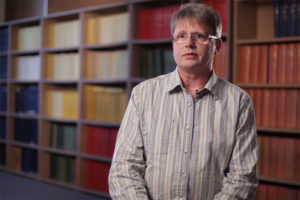Superfluidity of Light
Physicist Marzena Szymanska on the properties of photons, fluids of light and whether it’s possible to make a ...

On March 2, 2015 Nature Physics published a paper “Subnanometre-wide electron channels protected by topology” describing how a new class of topologically protected systems have been designed. We have asked one of the authors of this research, Prof. Markus Morgenstern from RWTH Aachen University, to comment on this work.
Solid state physicists have recently learned to use topological arguments in order to predict robust properties of materials. This type of analysis is quite abstract dealing with the continuity of spaces, but leads to a multitude of fascinating predictions which are partly already confirmed by experiments. One branch of this new field is analyzing the symmetry properties of the equations describing the bulk of a solid in order to predict robust properties at its surface. For example, certain symmetries of the electronic wave functions in the bulk of an insulator necessarily require that its surface is conducting. This phenomenon has meanwhile been found for several dozens of materials including materials which are known for decades without being recognized to have surface conductivity. The surface conductivity is moreover peculiar in the sense that it is automatically linked to a transport of magnetic information.
The same type of analysis predicts that some symmetries of the electronic wave functions in bulk insulators require that only part of the surfaces are conducting. The remaining ones are insulating except at its step edges, i.e., if you scratch a step edge into that surface, you automatically get a conducting electron channel at this step surrounded by an insulating area. The conduction of these channels again transports magnetic information, i.e. electron spins, and is extremely robust, if compared to other one-dimensional channels, i.e. the electron channel barely cares about disorder. Having such a material would, thus, allow drawing electron channels with desired device functionality directly into the surface.
However, so far, real materials with the corresponding symmetry are missing. In our collaboration, such materials have been designed by chemical means being inspired by the structure of graphene. Basically the atomic structure of graphene is reproduced using heavy atoms like Rh, Bi and I. The ‘heavy metal’ graphene layers are then stacked onto each other using a BiI interlayer which leads to the structure of B14Rh3I9. Theoretically, this structure has the right symmetry and, indeed, density functional theory calculations confirmed the existence of the particular symmetry required for the surface with electron channels at its edges.
Using this material, we could show experimentally by scanning tunneling microscopy that the electron channels exist at all step edges and that they are robust with respect to disorder, i.e. the electrons are not scattered at defects of the step edge. We could also show that a very similar system made by replacing Pt for the Rh has a slightly different symmetry and as predicted from the topological analysis does not exhibit the electron channels. This corroborates that the channels are indeed given by the symmetry of the equation, i.e. by topology. The electron channels are extremely small having a width of only 0.8 nm such that channel networks with very small footprint can be anticipated.
It is rather easy to produce the right surface just by cleaving the bulk material and to scratch step edges into it using a fine needle from an atomic force microscope, so far, with a precision of 10 nm.
Inspired by the quantum Hall effect discovered in 1980, meanwhile a resistance standard with a precision close to 10-10, theorists started to think about the origin of such a precision in a disordered system. They came up with a topological explanation being rather abstract but by construction disregarding the details of the disorder in the system. However, it took until 2007 that experimentalists found another effect in a solid based on such a topological reasoning, thereby inducing a gold rush on the novel method adapted from mathematics. Recent novel discoveries based on that reasoning include strong topological insulators, topological crystalline insulators, quantum spin Hall systems, anomalous quantum Hall systems and Majorana excitations. They all have in common that certain physical properties given by the topology are robust with respect to disorder or noise. This missing sensitivity to the uncontrolled details of the environment certainly makes their strength if it comes to applications. The current study adds a new class of such topologically protected systems called weak topological insulators. They have the unique advantage to provide robust electron channels which can be carved into a surface.
So far, the electron channels are completely occupied by electrons due to the actual surface chemistry. Thus, the transport properties are not directly available for devices. In the next step, we will modify the surface chemistry by adsorption such that electronic transport of the channels can be probed by a multiple tip instrument. If successful, new types of quantum devices using the magnetic properties of the edge channels, connection lines between magnetic memory cells or interfaces with superconductors leading to a more simple realization of Majorana excitations can be anticipated.

Physicist Marzena Szymanska on the properties of photons, fluids of light and whether it’s possible to make a ...

Physicist Martin McCall on artificial materials, control over the magnetic response, and perfect lenses

MIT Prof. Martin Z. Bazant on electrical double layer, electroosmotic flow, and deionization shock